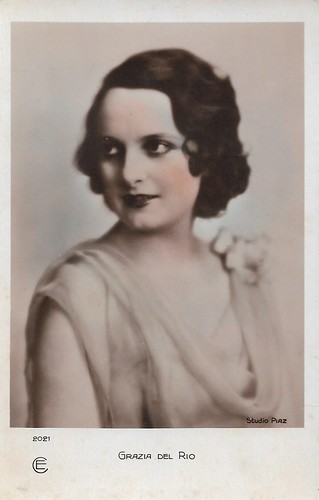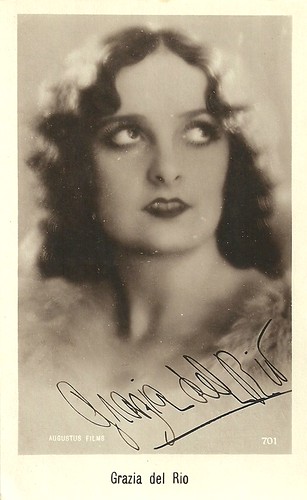Little is known about the personal life of Italian actress and singer Grazia Del Rio, but probably because of her singing voice and clear vocals she had a prolific career in the earliest years of sound cinema. Between 1930 and 1933 she had a short but intense film career in Italy and France, peaking with La stella del cinema (Mario Almirante, 1931) in which she starred as herself. In the late 1930s, she had a second career in Argentina and Chile.

French postcard by Cinémagazine-Editions, no. 2021. Photo: Studio Piaz.

French postcard by Europe, no. 992. Photo: Produzione Pittaluga Cines, Roma.
According to Elena Mosconi, Grazia Del Rio aka Gracia del Río came from Santiago, Chili, studied piano in Paris, and song and dance in Milan.
Grazia Del Rio became a music-hall actress. She herself claimed to have performed with the music-hall Za-Bum in the shows 'Broadway' and 'K.41'. Del Rio acted in one late silent film shot in Africa, Tramonto dei blasoni/Sunset of the blazons (Attilio Gatti, 1928), even if it is unsure whether that film really was released.
Her breakthrough came in 1930 with the earliest sound films made at the Cines Pittaluga studio in Rome, equipped for sound cinema in that year. Already in 1929 she sang in a short recorded by director Baldassarre Negroni, Serenata Tzigana/Gypsy Serenade (released in 1930), made to test the new sound equipment of the ENAC company.
Negroni would henceforth become a floor manager at the new Cines Pittaluga sound film studios. It was here that in 1930 Del Rio performed as singer and actress in a series of Cines shorts by Mario Almirante, including Donne alla fonte/Women at the source and Fantasia di bambole/Fantasy of dolls. The latter was found at the EYE Filmmuseum years ago.
Together with actor Elio Steiner, Del Rio played a host to the film spectators in the first of a series of shorts by Cines, called Rivista Cines. It showed the new studios and a visit by Minister Giuseppe Bottai . The short was shown together with what goes as the first Italian sound film, La canzone dell'amore/The Song of Love, at its premiere at the Roman Supercinema (now Teatro Nazionale) on 8 October 1930.
One month after, the film Nerone/Nero (Alessandro Blasetti, 1930) was released, an anachronistic comedy with Ettore Petrolini in the title role and Del Rio as his admirer. Then she played a supporting part in the Armando Falconi comedy Rubacuori/Heartbreaker (Guido Brignone, 1931).

Italian postcard. The back of this Italian postcard has a stamp promoting Grazia del Rio in Paris: "Grazia del Rio. TALKIES FILMS. Pianiste Concertiste. Vedette Internationale de Chant (5 langues) Danse et Musique. La Vedette en Italie de la "Za Bum"pour "Broadway" et "K.41". Parle sans aucun accent étranger le français, l'italien, l'espagnol et assez bien l'anglais. Sports: cheval, natation, patinage, etc. Adresse permanente: Via Cicerone 44 - ROME." Written on the card: "Act[uellement] 178, Bd. Berthier. Tel. Carnot 59-72."

French postcard by P-C, Paris, no. 25. Photo: Gaumont / Franco-Film / Aubert. Grazia Del Rio sang the 'valse musette' 'Les d'moisell's de Montparnasse' in La petite de Montparnasse/Die Mädels von Montparnasse (Hanns Schwarz, 1932). Text by Lucien Boyer, and music by F. Wachsmann. Copyright: Alrobi, Berlin/ Ed. Salabert, Paris.
Grazia Del Rio starred in the film La stella del cinema/The cinema star (Mario Almirante, 1931), about a debuting actress who is catapulted into stardom, while her fiancé (Elio Steiner) remains an extra. Twenty years before Stanley Donen's Singin' in the rain, the histrionic acting of the former silent film actress (Sandra Ravel) is discredited, and the 'au naturel' acting of the newcomer is favored as more apt to the new medium. The plot was an excuse to give a peek into the behind-the-screens of the modern Cines sound film studio and shows both actors and directors from the silent days and the new sound film generation. A few years ago, the film was fully restored and released on DVD.
Del Rio also went to France to act in early sound films there: first in La dernière berceuse/The last lullaby (Gennaro Righelli, 1931), the French version of Righelli's own La canzone dell'amore, starring Dolly Davis and Jean Angelo instead of Dria Paola and Elio Steiner, and with Del Rio in the part of Isa Pola.
This would be followed by Mon ami Tim/Fifty Fathoms Deep (Jack Forrester, 1932) with Jeanne Helbling and Thomy Bourdelle, and La petite de Montparnasse/The little one from Montparnasse (Hanns Schwarz, 1932), in which she starred herself, opposite Lucien Gallas.
In 1933 she had a supporting part in the comedy Les aventures du roi Pausole/The Adventures of King Pausole (Alexis Granowsky, 1933), starring André Berley and filmed at the Côte d'Azur. Del Rio also played in the German language version of the film, Die Abenteuer des Königs Pausole (1933), in which Emil Jannings played the title character.
Del Rio remained in France for three more films: the comedy Le tendron d'Achille/Achilles' Heel (Christian-Jaque, 1933), Le relais d'amour/The love relay (André Pellenc, 1933), and La nuit des dupes/The night of the Fools (Maurice Labro, Pierre Weill, 1933) with Roland Toutain.
After that, Grazia Del Rio's European film career was over. It is not entirely clear what happened to her.
She might have gone back to Chile. Her namesake Grazia Del Rio made various films in 1938-1940 in Argentina and Chile: in Argentina, Turbión/Turbion (Antonio Momplet, 1938), El misterio de la dama gris/The mystery of the gray lady (James Bauer, 1939), Ambición/Ambition (Adelqui Migliar, 1939), and La luz de un fósforo/The light of a match (Leopoldo Torres Ríos, 1940). In Chile, she also made Entre gallos y medianoche/Between roosters and midnight (Eugenio de Liguoro, 1940).

Italian postcard, no. 701. Photo: Augustus Films.
Signorina Grazia Del Rio (1931). Source: British Pathé (YouTube).
Rivista Cines n°1 il Cinema Sonoro di Luciano Muratori. Source: Ughetto50 (YouTube).
Sources: Elena Mosconi ('L 'altra Pittaluga', Immagine No. 16, 2017 - Italian), Taxidrivers (Italian), and IMDb.

French postcard by Cinémagazine-Editions, no. 2021. Photo: Studio Piaz.

French postcard by Europe, no. 992. Photo: Produzione Pittaluga Cines, Roma.
Music-Hall
According to Elena Mosconi, Grazia Del Rio aka Gracia del Río came from Santiago, Chili, studied piano in Paris, and song and dance in Milan.
Grazia Del Rio became a music-hall actress. She herself claimed to have performed with the music-hall Za-Bum in the shows 'Broadway' and 'K.41'. Del Rio acted in one late silent film shot in Africa, Tramonto dei blasoni/Sunset of the blazons (Attilio Gatti, 1928), even if it is unsure whether that film really was released.
Her breakthrough came in 1930 with the earliest sound films made at the Cines Pittaluga studio in Rome, equipped for sound cinema in that year. Already in 1929 she sang in a short recorded by director Baldassarre Negroni, Serenata Tzigana/Gypsy Serenade (released in 1930), made to test the new sound equipment of the ENAC company.
Negroni would henceforth become a floor manager at the new Cines Pittaluga sound film studios. It was here that in 1930 Del Rio performed as singer and actress in a series of Cines shorts by Mario Almirante, including Donne alla fonte/Women at the source and Fantasia di bambole/Fantasy of dolls. The latter was found at the EYE Filmmuseum years ago.
Together with actor Elio Steiner, Del Rio played a host to the film spectators in the first of a series of shorts by Cines, called Rivista Cines. It showed the new studios and a visit by Minister Giuseppe Bottai . The short was shown together with what goes as the first Italian sound film, La canzone dell'amore/The Song of Love, at its premiere at the Roman Supercinema (now Teatro Nazionale) on 8 October 1930.
One month after, the film Nerone/Nero (Alessandro Blasetti, 1930) was released, an anachronistic comedy with Ettore Petrolini in the title role and Del Rio as his admirer. Then she played a supporting part in the Armando Falconi comedy Rubacuori/Heartbreaker (Guido Brignone, 1931).

Italian postcard. The back of this Italian postcard has a stamp promoting Grazia del Rio in Paris: "Grazia del Rio. TALKIES FILMS. Pianiste Concertiste. Vedette Internationale de Chant (5 langues) Danse et Musique. La Vedette en Italie de la "Za Bum"pour "Broadway" et "K.41". Parle sans aucun accent étranger le français, l'italien, l'espagnol et assez bien l'anglais. Sports: cheval, natation, patinage, etc. Adresse permanente: Via Cicerone 44 - ROME." Written on the card: "Act[uellement] 178, Bd. Berthier. Tel. Carnot 59-72."

French postcard by P-C, Paris, no. 25. Photo: Gaumont / Franco-Film / Aubert. Grazia Del Rio sang the 'valse musette' 'Les d'moisell's de Montparnasse' in La petite de Montparnasse/Die Mädels von Montparnasse (Hanns Schwarz, 1932). Text by Lucien Boyer, and music by F. Wachsmann. Copyright: Alrobi, Berlin/ Ed. Salabert, Paris.
Where did Grazia go?
Grazia Del Rio starred in the film La stella del cinema/The cinema star (Mario Almirante, 1931), about a debuting actress who is catapulted into stardom, while her fiancé (Elio Steiner) remains an extra. Twenty years before Stanley Donen's Singin' in the rain, the histrionic acting of the former silent film actress (Sandra Ravel) is discredited, and the 'au naturel' acting of the newcomer is favored as more apt to the new medium. The plot was an excuse to give a peek into the behind-the-screens of the modern Cines sound film studio and shows both actors and directors from the silent days and the new sound film generation. A few years ago, the film was fully restored and released on DVD.
Del Rio also went to France to act in early sound films there: first in La dernière berceuse/The last lullaby (Gennaro Righelli, 1931), the French version of Righelli's own La canzone dell'amore, starring Dolly Davis and Jean Angelo instead of Dria Paola and Elio Steiner, and with Del Rio in the part of Isa Pola.
This would be followed by Mon ami Tim/Fifty Fathoms Deep (Jack Forrester, 1932) with Jeanne Helbling and Thomy Bourdelle, and La petite de Montparnasse/The little one from Montparnasse (Hanns Schwarz, 1932), in which she starred herself, opposite Lucien Gallas.
In 1933 she had a supporting part in the comedy Les aventures du roi Pausole/The Adventures of King Pausole (Alexis Granowsky, 1933), starring André Berley and filmed at the Côte d'Azur. Del Rio also played in the German language version of the film, Die Abenteuer des Königs Pausole (1933), in which Emil Jannings played the title character.
Del Rio remained in France for three more films: the comedy Le tendron d'Achille/Achilles' Heel (Christian-Jaque, 1933), Le relais d'amour/The love relay (André Pellenc, 1933), and La nuit des dupes/The night of the Fools (Maurice Labro, Pierre Weill, 1933) with Roland Toutain.
After that, Grazia Del Rio's European film career was over. It is not entirely clear what happened to her.
She might have gone back to Chile. Her namesake Grazia Del Rio made various films in 1938-1940 in Argentina and Chile: in Argentina, Turbión/Turbion (Antonio Momplet, 1938), El misterio de la dama gris/The mystery of the gray lady (James Bauer, 1939), Ambición/Ambition (Adelqui Migliar, 1939), and La luz de un fósforo/The light of a match (Leopoldo Torres Ríos, 1940). In Chile, she also made Entre gallos y medianoche/Between roosters and midnight (Eugenio de Liguoro, 1940).

Italian postcard, no. 701. Photo: Augustus Films.
Signorina Grazia Del Rio (1931). Source: British Pathé (YouTube).
Rivista Cines n°1 il Cinema Sonoro di Luciano Muratori. Source: Ughetto50 (YouTube).
Sources: Elena Mosconi ('L 'altra Pittaluga', Immagine No. 16, 2017 - Italian), Taxidrivers (Italian), and IMDb.
No comments:
Post a Comment